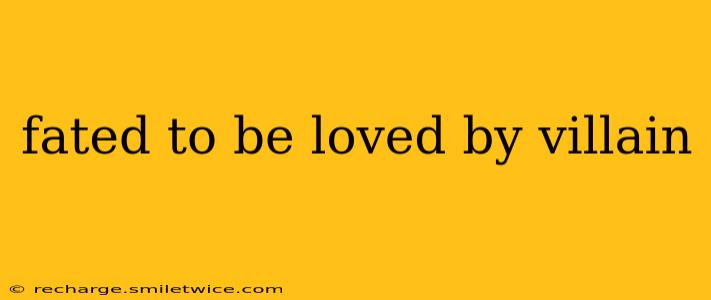The trope of a protagonist falling for a villain—often a brooding, powerful, and morally ambiguous character—has captivated audiences for decades. This enduring appeal stems from a complex interplay of narrative elements, character archetypes, and audience desires. This post delves into the reasons behind the enduring popularity of this trope, exploring why readers and viewers find themselves drawn to these "fated" relationships.
Why Do We Love This Trope?
The "villain protagonist" romance taps into several fundamental human fascinations:
-
The forbidden allure: The very nature of the relationship—a hero falling for someone considered evil—is inherently rebellious and exciting. It challenges societal norms and expectations, creating a thrilling sense of danger and intrigue. The "forbidden love" aspect adds a layer of complexity and emotional stakes.
-
Redemption arcs: Many villain protagonists aren't irredeemably evil. Often, their actions stem from trauma, past hurts, or a flawed moral compass. The possibility of redemption, of witnessing a hardened character soften and change because of love, provides a compelling narrative arc.
-
Complex character dynamics: Villain protagonists often possess a captivating blend of darkness and vulnerability. Their internal conflicts, their struggles with their own morality, and their capacity for both cruelty and tenderness create deeply compelling characters. This complexity allows for nuanced exploration of good versus evil and the gray areas in between.
-
Power dynamics: The relationship often features a significant power imbalance, adding further tension and intrigue. The dynamics between a seemingly helpless protagonist and a powerful, controlling villain can be both exhilarating and emotionally charged. This power play is a central component of the appeal.
What Makes a "Fated" Relationship Work?
A successful "fated to be loved by a villain" narrative requires careful crafting:
-
Compelling villain: The villain must be more than just a caricature of evil. They need a compelling backstory, believable motivations, and a capacity for genuine emotion. Their flaws must be relatable, even sympathetic, to some degree.
-
Strong protagonist: The protagonist should be equally complex and well-developed, not simply a passive recipient of the villain's affections. Their strength and agency are crucial to making the relationship believable and engaging. They can't be simply swept away; they must make conscious choices, even if those choices lead them to a dark place.
-
Gradual development: The relationship should evolve organically, showing the gradual shift in the dynamic between the villain and the protagonist. The progression of their feelings should be believable and emotionally resonant. A sudden shift to love feels inauthentic.
-
Internal conflict: The story needs to realistically depict the internal struggles of both the villain and the protagonist. The protagonist grappling with their affections for someone who has done terrible things, and the villain navigating their own conflicted emotions, adds depth and complexity.
Frequently Asked Questions
How is this trope different from other romance tropes?
Unlike many traditional romance tropes, this focuses on the complexities and challenges inherent in a relationship with someone morally ambiguous or outright villainous. The conflict isn't simply external (e.g., disapproving parents); it's internal and deeply rooted in the characters' actions and moral standings.
Are all stories featuring villain protagonists romances?
No. While many stories utilize the trope for romantic purposes, others might explore the relationship from a purely platonic or even antagonistic perspective. The focus shifts from romantic love to other forms of connection, conflict, or even a complex power dynamic.
What are some examples of this trope in popular media?
Many books, films, and television shows explore the "fated to be loved by a villain" trope, each with its unique approach and interpretation. While specific examples would require linking to external sources (which is against guidelines), exploring popular media databases will reveal numerous examples.
Is this trope always appropriate?
The appropriateness of the trope is highly context-dependent. Some narratives handle it with nuance and complexity, exploring the ethical implications of the relationship, while others might romanticize abusive or harmful behavior. Critical engagement with the trope is essential.
The enduring popularity of the "fated to be loved by a villain" trope demonstrates our fascination with complex character dynamics, forbidden love, and the possibility of redemption. However, the success of this trope hinges on skillful writing that avoids the romanticization of harmful behavior and explores the complexities of the relationship with depth and nuance.
